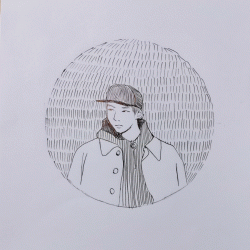WALK CYCLE
11/01/2021
I was relieved to hear that we didn’t have to design a character for the walk cycle, as there would be so many things to consider and keep an eye on.
I realised this when I did my first line test of the legs where the head of my figure got bigger and higher as it progressed.

On my second line test after fixing the head and adding the arms, I felt more optimistic. I also found that adding a line for the ground the figure is walking on helped make the end result more realistic.

I was happy with how the inbetweens turned out, now wary of the sizes of each body part and using my pencil for scale to make sure nothing was getting bigger or smaller.

On my final line test after repeating all the frames for the other side of the arm, it felt like a pretty decent walk cycle and I quite like the end result.

It would be interesting to be able to add more flare and characterisation to the figure (even though I was worried about character design initially) by altering their walking style and pace.
HEAD TURN
12/01/2021
For this, we had to design a character and their head turns, determining their feelings and their movements.
These were some initial characters I could think of, including a napping dog that heard someone coming in, a doll who noticed someone coming in and went back to being a doll, a less-than-thrilled birthday girl who rolled her eyes, and a mobster who heard a suspicious sound.

I went with the dog in the end as I had a lot of ideas for it, and the design is inspired by my actual dog who gets very excited when he hears the word “walk”.
With this, I planned out the key frames of the animation, from sleeping, to slight ear movements, followed by a quick head turn. The ear and jowl will follow the head’s quick movement.

I drew out the key frames and did a rough line test to time out each movement.

After I was happy with this, I went on to create the inbetweens following the guide I made based on the line test.

I wasn’t happy with how this turned out, sadly. I found that I’d often get lost into creating the inbetweens that I don’t consider enough the idea of easing in and out and leaving enough time for the follow through action to come to a completion. Because of this, this animation suffered the same issue as the conductor. I would love to come back to this, however, and fix it to create something I’m happy with.
Paper work animation isn’t easy, even though I’ve done it before in my foundation year. There are a lot of things to always be aware of, and you won’t know what your animation looks like until you go through the trouble of doing the line test.
Some of the animation I made weren’t perfect and I wasn’t happy with the results, though I want to come back and fix them and improve. I felt like this dissatisfaction goes to show that I am invested enough in this field to want to perfect it as the process, though meticulous and difficult, was incredibly enjoyable for me.
